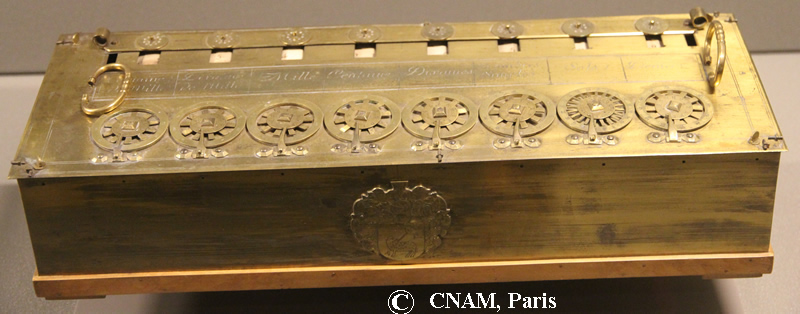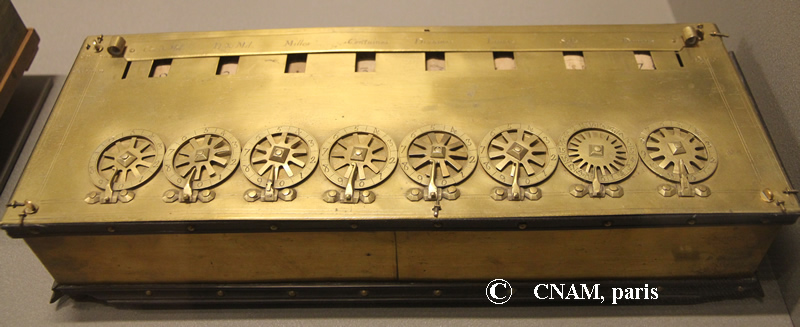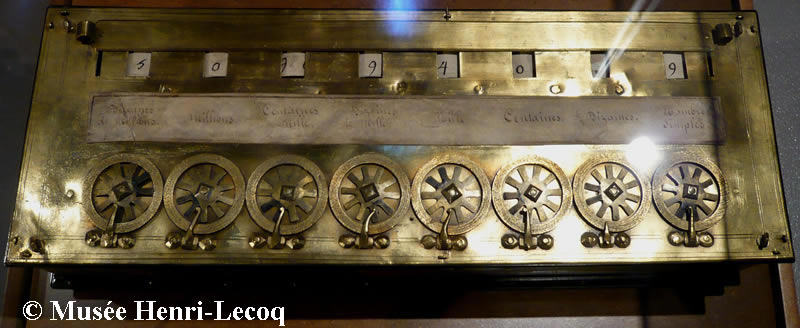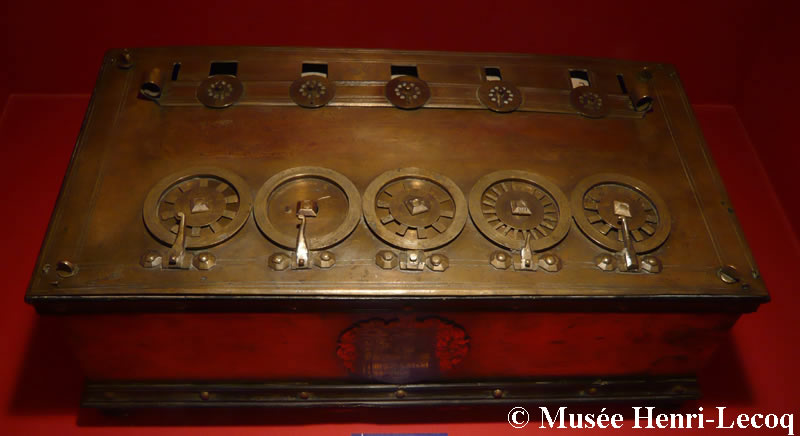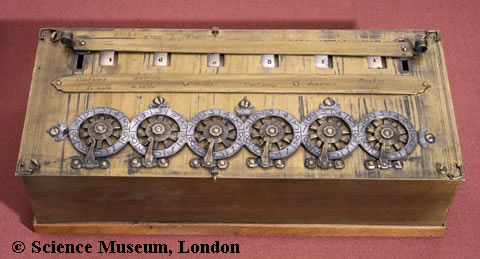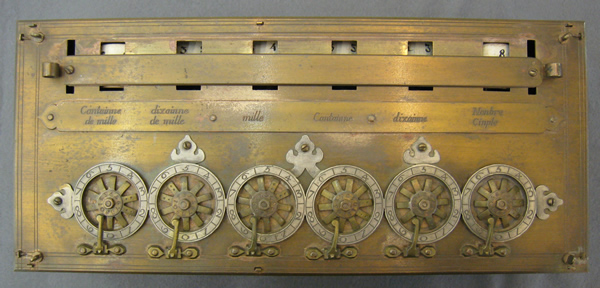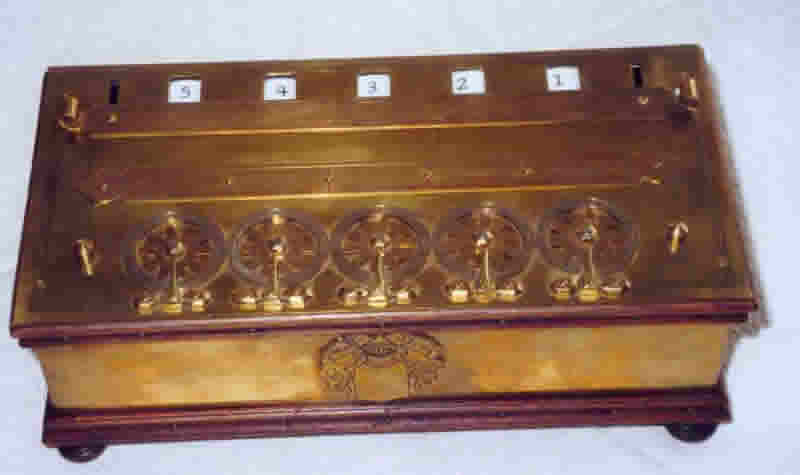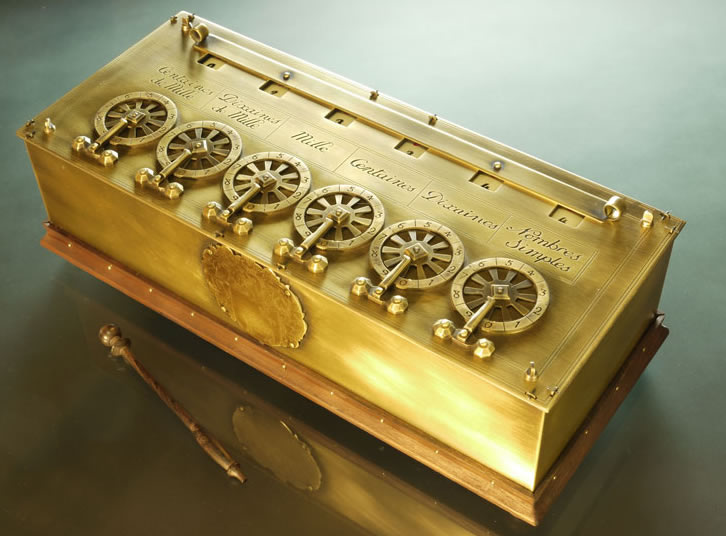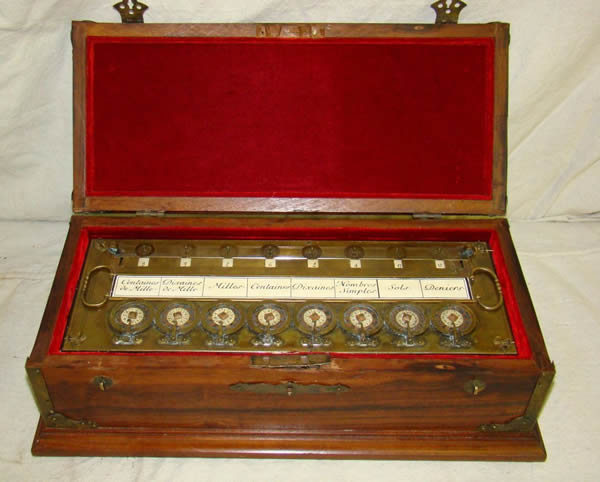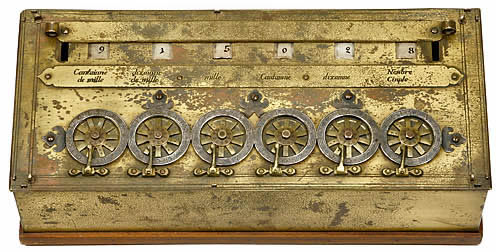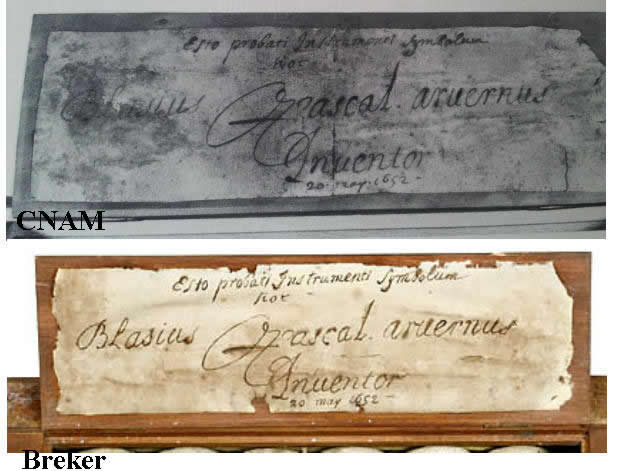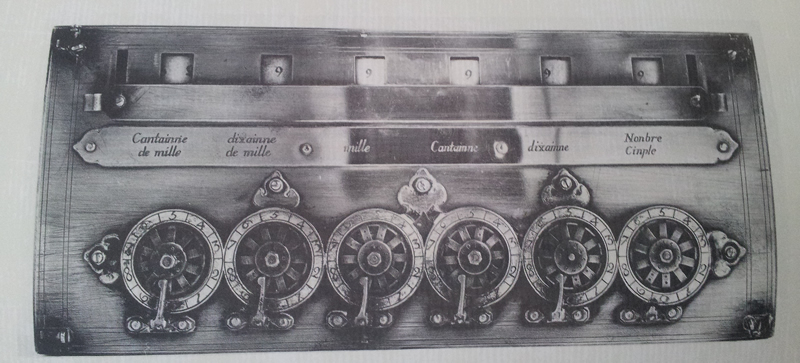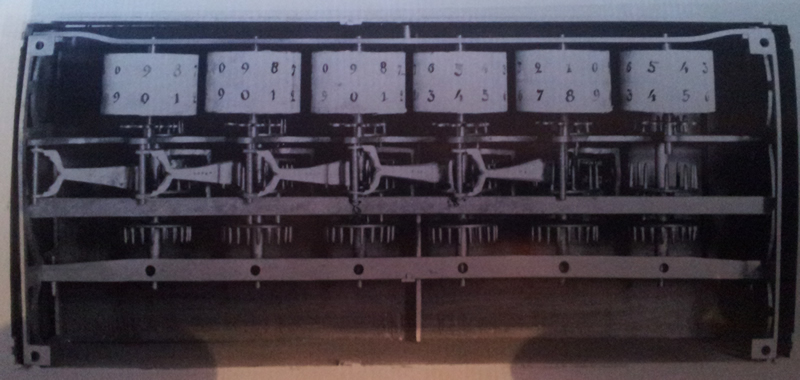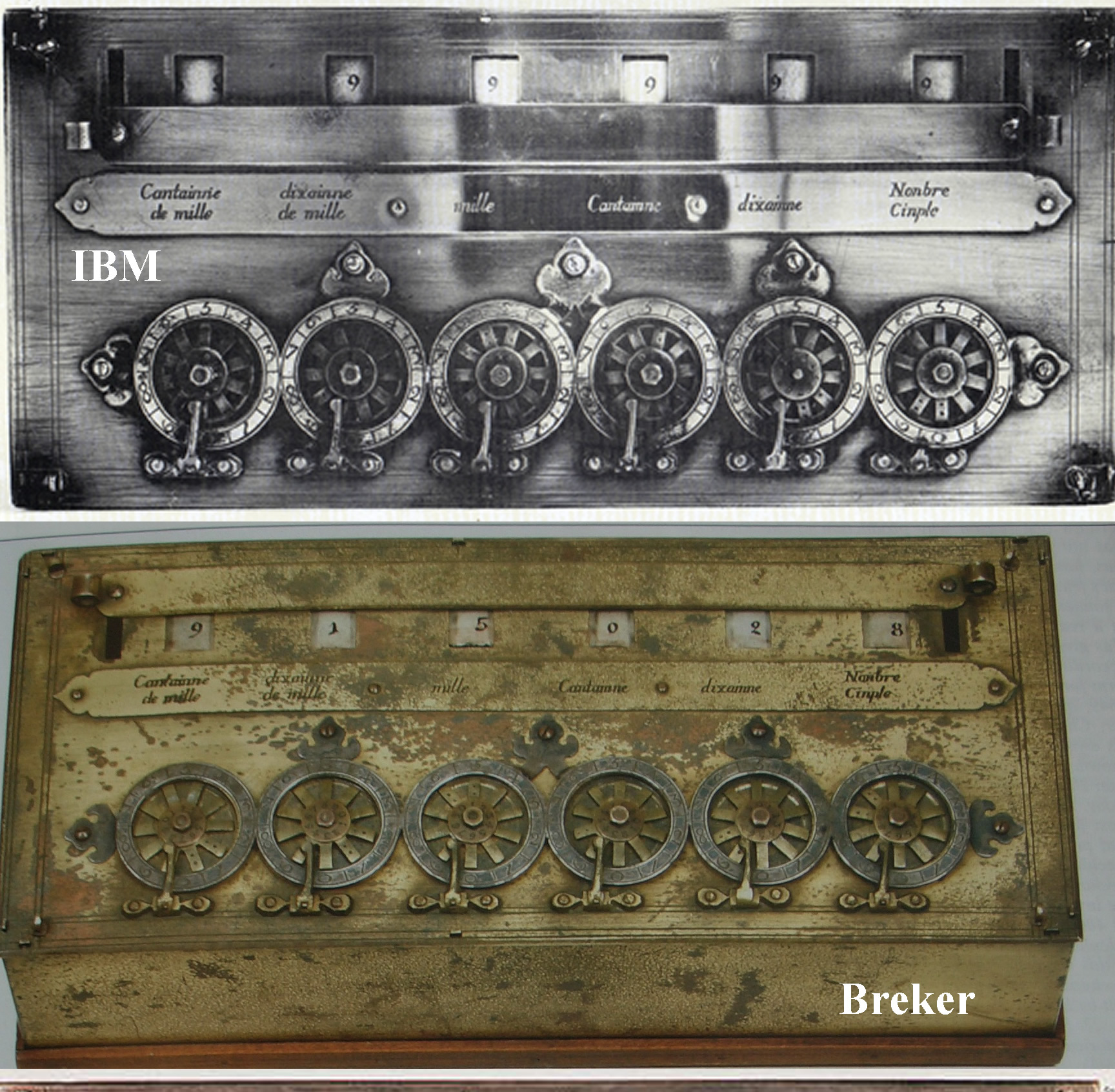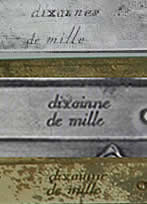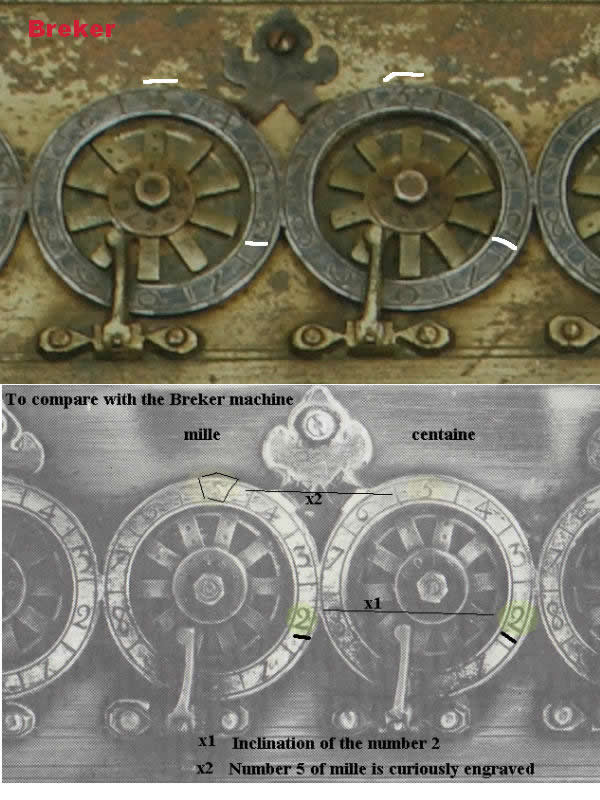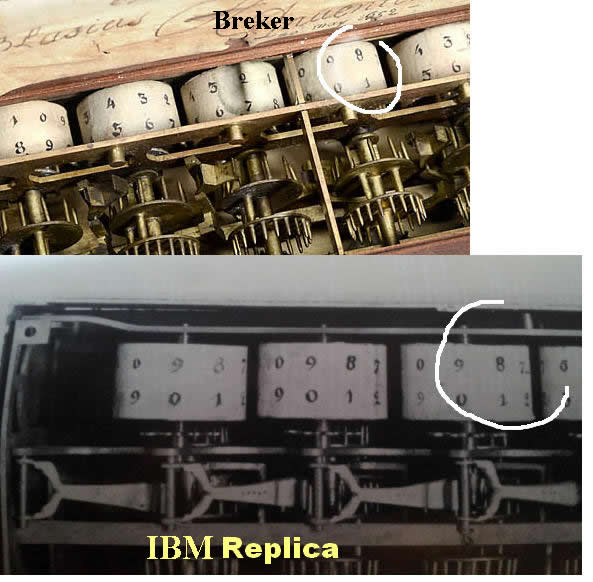For the international community, the sale of one of Pascal’s calculators is always a very exciting event. This is because Pascal’s calculator was the first mechanical calculator to have an automatic carry mechanism. Blaise Pascal was born on June 19th 1623 in Clermont-Ferrand. His mother died when he was 3 years old. It is his father, a Math and Science enthusiast who tutored him. They moved to Paris in 1631, and then in 1639, they moved to Rouen where his father became deputy commissioner of taxes for the region of upper Normandy. While his father was swamped by unending computations, both for administrative and accounting works, Blaise developed the idea of building an arithmetic machine to ease his father’s burden. In 1645, after 3 years of research and many trails, he built the first functional arithmetic machine, with a fully automatic carry mechanism!! Pascal was only 22 years old then!
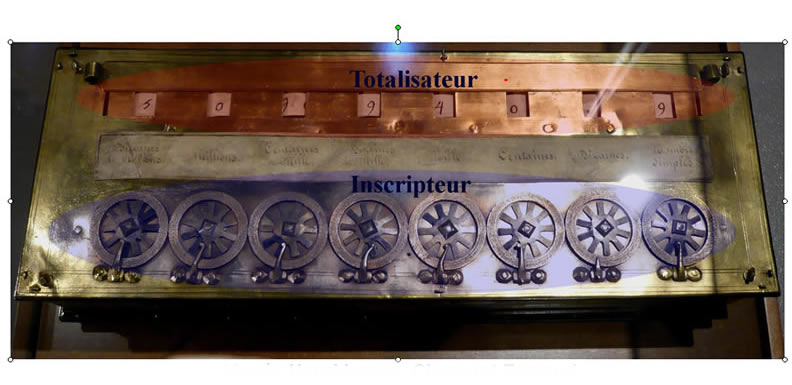
Quick description of the machine
The mechanism is enclosed in a rectangular box which top panel can be divided into two main parts: the input dials and the accumulators. The input dials are used to inscribe the number to be added or subtracted. They are composed of spiked wheels, mounted on independent axels, each one corresponding to a given order of a scientific or monetary number. Each wheel works like a rotary phone dial, with an outside numbered wheel and a metal stop which are fixed, mounted on the box itself, and a spiked wheel which is mobile. To inscribe a digit, the operator must insert a stylus in between the two spikes that surround the digit written on the outer wheel and he must turn the wheel with the stylus all the way to the stop lever. Each spike corresponds to one unit in the base of the wheel (decimal or monetary). The wheel for “denier” has 12 spikes, the one for « sol » has 20 spikes and a decimal wheel has 10 spikes! The wheel rotation powers the mechanism which in itself is extremely simple. One can find in it some lantern gears, which transmit the data to the accumulators, pawls and ratchets which allow for the proper positioning of the various wheels, and a set of “sautoirs” which are dedicated to transmitting carries from one wheel to the next wheel of higher order.
It is believed that Pascal built twenty machines. Nine have survived. Most are in public collections, except for two of them.
Musée des Arts et Métiers, Paris (CNAM) |
| |
|
Machine de la reine Christine de Suède |
Machine de Louis Périer |
|
|
Machine du Chancelier Séguier |
Machine tardive |
|
|
| Musée Henri-Lecoq, Clermont Ferrand |
| |
|
Machine de Marguerite Périer |
Machine du Chevalier-Durant-Pascal |
|
|
| Mathematisch-Physikalischer Salon, Dresde, Allemagne |
| |
|
Accounting machine |
| |
| Private collection of Mr Parcé |
| |
|
Surveying machine
|
|
|
Replica by Ernest Rognon, 1926
Clockmaker at the Conservatoire des Arts & Métiers |
| |
|
Replica of the machine de la Reine Christine de Suède, British Museum, London
|
|
|
IBM
Replica of Roberto Guatelli, 1981 |
| |
|
|
|
IBM
Replica built by the employees of IBM (source : Mourlevat) |
| |
|
|
|
| Replicas built by Pierre Charrier, France |
| |
|
|
|
|
|
| Jan Meyer's replica (Ebay, 28/10/2012) |
| |
|
|
|
|
|
C) Replicas sold as originals |
To find the 10th Pascaline is a dream shared by most of us. It is not impossible that, one day, a machine will be found in an attic and that it will end up at public auction. This brings the problem of authenticating the machine, because, the more an object is valuable the more it arouses keen interest. To call a replica an original is therefore very tempting.
Auction held on 28 march 2009 / Philip Weiss |
This story caused a good deal of commotion and generated a lot of fierce debates amongst the international community of calculator collectors (discussion groups). Finally, the auction house recognised that it could be a replica from Dr. Guatelli but kept alive the possibility that it could still be a real one until the end of the auction. The machine sold for $19,000, which is a very high price for a replica. In this story, it was hard to argue because of the lack of documentation and pictures which could have proven for a fact that it was a replica from Dr R. Guatelli.
Breker auction, May 25th 2013 |
On the 25 of May 2013 the auction house Breker will sale what they call an original Pascaline. Just by looking at the pictures something didn’t add up. A sticker similar to the one found in the Reine de Suède Pascaline, owned by the CNAM, was proudly apposed on the inner side of the wooden door that hides the inner mechanism. The auction house was immediately notified. Unconvinced, they have asked for proofs which are presented hereafter:
The sticker, glued inside the « Breker » machine, is an identical copy of the one found in the Reine de Suède machine. One just needs to compare these two pictures to be convinced of it. Not only the texts are identical, but the position of each word and the graphological similitude lead to think that this sticker is a copy. It is possible that Pascal finished building two identical machines and that he certified them the same day (they both have the date of May the 20th 1652). He could have copied the first text by transparency in order to be certain to lock the words in position on the second sticker. It is possible to see some small differences in between the two, which proves that it was not a perfect Xerox copy. Could Pascal have finished building 2 machines of the same type, almost identical, and have verified them the same day? All right ... the problem is the existence of a third sticker, created in 1926 by Ernest Rognon, a clock maker working from the CNAM at the time. The machine on which this sticker is affixed can be seen in the Science Museum of London, England.
| Stickers from CNAM and Breker |
| |
|
|
|
|
|
| Sticker from the replica by Ernest Rognon, 1926 (Science Museum, Londres) |
| |
|
|
|
|
|
2) The IBM replica that was a sensation at the Bargoin museum in 1981 |
In 1981, a superb exhibition was held at the Bargoin museum, in Clermont-Ferrand, France. All the known Pascalines were reunited! All but one, the 8 digit machine owned by IBM was missing. Instead IBM sent a replica of the Reine de Suède machine owned by the CNAM since 1807. This replica caused a stir because of the quality of its workmanship (“the fidelity of the work in reproducing this machine, which had been executed by IBM’s workers, was admired by all” / Mourlevat, page 44). Two pictures of this replica were taken. They are kept at the “CRDP d’Auvergne” and were printed in Mourlevat’s book: “planche 44 and 45”.
| IBM replica, exhibited to Bragoin Museum in 1981 |
| |
|
|
|
|
|
|
3) Comparative analysis of the two machines top panels (IBM / Breker replica) |
At first glance their incredible similarity is striking. The top of the box is made of brass, it sits on a wooden base. There are 6 decimal input wheels. The place value of each digit is engraved on a ruler held in place by four rivets.
One can read, from right to left: « Nombre cinple, dixainne, cantainne, mille, dixainne de mille, cantainne de mille ». It is important to note that the typography is absolutely identical on the two machines, but we’ll come back to it later. A movable ruler hides half of the accumulator windows (used in nine’s complement arithmetic). Reference wheels are engraved with a series of numbers from 0 to 9. Inner wheels of subtraction are mounted inside the spiked wheels; they are used to enter the complement of a number during the first phase of a subtraction. Two contiguous spikes are marked on each wheel. They allow for an easy way to reset the machine. Each wheel dial fixation is reinforced by a small decorated piece held in place by a screw. There is no coat of arms. As for differences it must be noted that the Breker machine looks aged. Also, the small metal pieces that reinforce the fixation of the input wheels are more finely engraved on the Breker machine, but their outlines looks identical.
4) Comparaison IBM / CNAM / Breker |
Since the IBM replica was brought to the Bargoin museum in 1981 in order to cause a sensation, it is easy to imagine that it resembles perfectly the one which it was a copy of.
There is however one element that keeps them apart; this is the typographic characters engraved on the ruler, they are totally different on the CNAM machine where the writing is thinner and less well centered. By contrast, on the IBM replica, the characters are thicker and, most of all, perfectly centered. The characters on the Breker machine are identical to the ones on the IBM replica, which leads us to believe that they were made by the same person.
5) The « Dixainne de mille » mistake |
On the CNAM machine, the spelling of the order words is a bit unusual: « Nonbre cinple, Dixainne, Dixaines de mille … ». Concerning the words Dixainne / Dixaine, with one or two n, it seems that they were both used interchangeably during the 17th century. On the IBM replica, the person that built it made a small copying mistake when he engraved « Dixainne de mille » instead of « Dixaines de mille », which is the way it is on the Reine Christine de Suède (CNAM) machine. This small mistake is really nothing except that it is also found on the Breker machine! This is really disconcerting and goes against it being an original.
Have the IBM replica and the Breker machine been built by the same passionate hands?
| The "Dixain(n)es de mille |
| |
|
CNAM, IBM, Breker
|
|
|
6) Digits engraved on the outer wheels |
The similarity in between the digits engraved on the outer wheels of the IBM replica and on those of the Breker machine is disturbing. The example of the digit 2 is quite revealing. On the IBM machine, the “engraved” number 2 leans differently on the wheel of the Centaines and on the one of the Mille. This difference can also be found and is identical on the Breker machine!! This is really unsettling.
| Outer wheels |
| |
|
Example of number 2
|
|
|
7) Digits written on the cylinders |
There is a strong graphological resemblance in between the two machines. For instance, on one of the cylinders (the one for thousands) of the IBM machine, the number 8 is thicker on its upper half. It is similar on the Breker machine.
| Les cylindres du totalisateur |
| |
|
Breker vs IBM
|
|
|
In all the machines built by Blaise Pascal, there is a flat decorating baton strip built around the top and the bottom of the machine. Many machines lost this decoration but they all have the holes of the nails that held them in place. In contrast, the IBM replica and the Breker machine have no baton strips and no leftover holes showing. It is important to remember that the “workers” that built the IBM replica of the CNAM machine tried to copy it perfectly. Since the CNAM machine didn’t have an upper baton strip, they decided not to replicate the holes, it is that simple…
9) Location of the tightening fixtures |
The location of the tightening fixtures mounted on top of the machine is identical on both the Breker machine and the IBM replica. These fixtures are located where the horizontal and vertical decorative lines meet. This is not the case on the original machine of the CNAM.
| tightening fixtures |
| |
|
Breker vs IBM vs CNAM
|
|
|
9) The restored lever stop on the CNAM machine |
A long time ago the stop lever on the wheel of the 10s was restored on the original CNAM machine. Most likely, the lever was completely redone. Both the IBM replica and the Breker machine have copied this particularity, which cast an additional doubt as to their originality!
| Lever stops |
| |
|
Breker vs CNAM
|
|
|
10) The other IBM replica |
It turns out that the more one searches, the more one finds replicas that look like the replicas!! There is enough here to make your head spin. The pictures below show three machines, all of which were made by IBM. There are a few differences in between them, but there are a lot more similarities!! The typography used on the ruler that shows the 10s column are all identical and they are all identical to the Breker machine.
All these observations go against the originality of the machine to be sold by Breker this coming May the 25th. It is urgent to complete this detective work so that the truth can really shine through. It seems that IBM’s replica had a few little sisters after all, which in itself is not a crime as long as they are identified as such. It is true that the "Breker" machine is superb and that it was built with great care. Nobody can deny that! and some replicas are sometimes more beautiful that the originals they are meant to represent!! But a replica is a replica!
Regarding the similarity in between the numbers inscribed on the replica’s outer wheels, one wonders whether they were engraved or molded? In case they were molded, it could be theorized that multiple molding matrices were built and that they were used in the making of tens of outer wheels. This could explain that almost identical wheels can be found on different machines. Other parts might have been molded? We would have to find one of the IBM workers that built the machines to be sure!!
To be continued….
/ Valéry Monnier
Serge Roube
Sources
Musée des Arts et Métiers, Paris (CNAM)
Musée Henri-Lecoq, Clermont-Ferrand
Mathematisch-Physikalischer Salon, Dresde, Allemagne
Science Museum, Londres
IBM
Collection Parcé
Auction Team Breker, Cologne
www.ami19.org
2013
|



